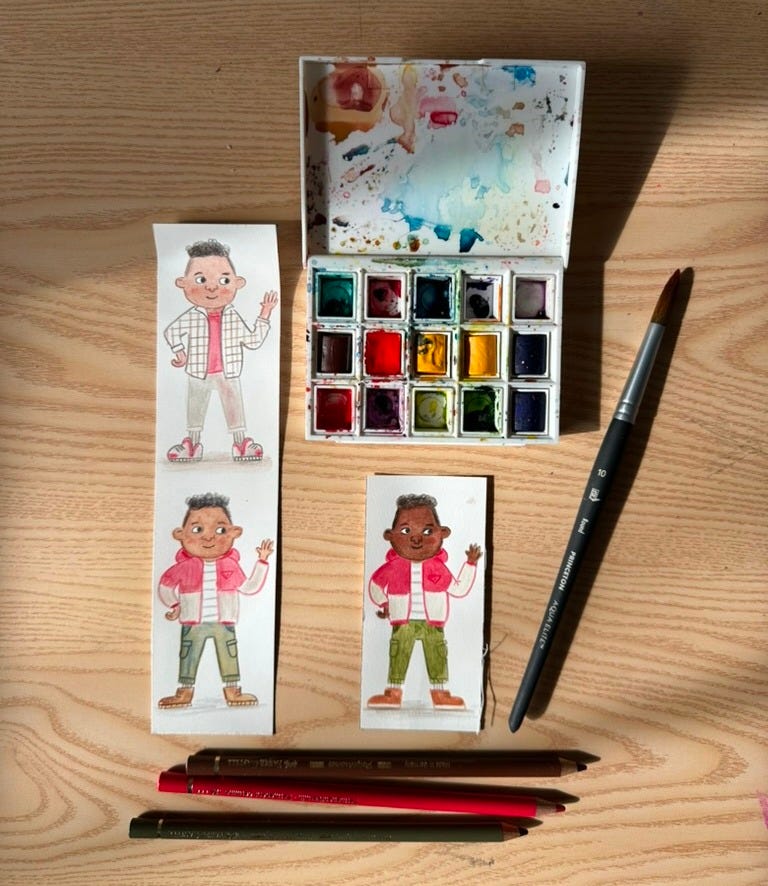3 Ways I Prepare for Working with Non-Traditional Publishing Clients
So I’m ready when they reach out!
Want to listen while you’re drawing or painting? Just click play to hear me read the post!
Hi everyone!
I’m working on a multi-post series all about Working with Non-Traditional Publishers, including clients who are self-publishing their books. These could be individual clients, non-profit organizations, or anyone else who isn’t a traditional publisher. I’m working on my fifth book in this category, and surprisingly, it’s been full of wonderful experiences.
I encourage you to read the first post in the series here:
In that post, I share about why I think some self-published books are worth illustrating. And if you’ve decided maybe it’s worth it for you too, then I welcome you to keep reading. If you’re more interested in sticking with traditional publishing, that’s totally fine!
Alright, if you’re here to prepare yourself for working with non-traditional publishers, this post is all about some action steps you can take now so that you’re ready for when an enquiry lands in your inbox later!
Have a website with a contact form.
Prepare a Picture Book Info + Pricing Brochure (this is the main step).
Be on the look-out for opportunities.
Let’s go through each one individually…
1. Have a website with a contact form
I know, this sounds so basic, and you probably already have this on your website! But I figured this is a non-negotiable step for preparing to work with clients, so I had to mention it. After all, it’s the most straightforward way for people to reach out for possible commissions. And sometimes people prefer a contact form over an email address, because it’s less intimidating if they don’t know exactly what to say or what questions to ask, especially if this is the potential client’s first book project, which is a common scenario in self publishing. So having a form with a few drop down menus is a nice option. Here’s mine.
2. Create a “Picture Book Info + Pricing Brochure”
This is a bit more of a lift than adding a contact form to your website, but I’ve found it to be a game changer.
When a potential client reaches out, they’re going to have a lot of questions. Here are some questions I’ve been asked in the past…
How long does it take to illustrate a book?
How much does it cost? What do other illustrators charge? Do I pay all at once?
Can you do a sample or test illustration first?
Who owns the illustrations after?
So rather than answer all of these questions individually each time a potential client asks them, I prepared a “Picture Book Info + Pricing Brochure” that can be shared with clients. It is packaged nicely and helps me to look professional and organized. I want people to know that I am a professional artist. Additionally, the brochure is much more efficient than having a million emails back and forth—which can really slow the momentum of possibly getting hired.
What to include in it: Make a list of all the questions you think a potential client might have. Use that as your outline for what to include in your brochure. Feel free to refer to the list of questions above! Those are real questions from people who have reached out to me.
How to make it: I made mine in Canva, but you can use whatever program you like! Google Docs, In Design, or anything else works. And definitely include your illustrations throughout the document!
When to send it: I’ve experimented with sending the brochure immediately after receiving an enquiry, and also waiting to send it until after a call. I prefer meeting or talking first and then sending my brochure, because then the client has a sense of me and who I am as a person while they browse the brochure. It creates more of a personal and emotional connection rather than sending a pdf without any sense of who I am… at least beyond my portfolio and website.
Paid subscribers can have a look at the exact pricing brochure that I send to potential picture book clients. The link to download it is at the bottom of this post.

3. Be on the look-out for opportunities
Don’t overthink this one! This just about keeping a casual look-out for potential work. I saw this post by
:It’s all about being ready when an opportunity comes. That idea has really stuck with me. We’re doing the work now so we’re ready later.
Here are some examples of what I mean:
Example 1:
A client found my portfolio on Upwork, and they reached out to me. Now I’ve been hired for my highest paying book yet by my most well known client yet - The American Kennel Club! So that is really cool! By just having a discoverable profile in a place that potential clients hang out, I was able to get hired for a book.
Please note that websites such as Upwork and Fiverr aren’t my favorite place to find jobs, and I wouldn’t encourage anyone to spend too much time applying to jobs there. But I figure it can’t hurt to at least make a profile and be discoverable on these sites. You never know who might be browsing. Linked In is another place to consider making a profile.
Example 2:
I am a member of my neighborhood’s community Facebook group. Someone recently posted that they’re looking for an illustrator for their book. I offered to do a paid character sample. (Side note: I’ve discovered it’s more accessible to have a lower cost entry point, because having to commit for a whole book project can be quite overwhelming, especially for someone who is not in the publishing industry. Just think of a character sample as a small commission.) So I sent him the character sample below, and now he’s deciding if he’d like to move forward.
This potential job was from my community Facebook group, of all places. Who even thought you could get work there?? I sure didn’t! Now I’m thinking about what other communities I can join where people might be looking for illustrators. And if an opportunity arises, my plan is to be able to respond quickly and in a way that shows I am ready, confident, professional, and capable.
That’s what I mean by “be on the look-out for opportunities.” It can be casual. Just give yourself a few more chances at visibility online, but don’t overthink it. These spaces aren’t guaranteed to provide any work opportunities, but if something does arise, you’ll be there and you’ll be ready.
Ok! How was that for some steps for preparing to work with non-traditional publishers? I hope they seem actionable and doable. Here’s a recap of them:
Have a website with a contact form.
Make a “Picture Book Info + Pricing Brochure” that can be shared with clients.
Casually look-out for jobs: Create profiles on various sites, such as Linked In to increase your online presence and join online groups, such as your neighborhood Facebook group
I hope this was helpful and shows that working with non-traditional publishers can be really great, if done right with thoughtful preparation. If you have anything to add about what I wrote, I’d love to hear about it in the comments!
And for paid subscribers, here is my Picture Book Pricing Brochure that I send to potential clients:





